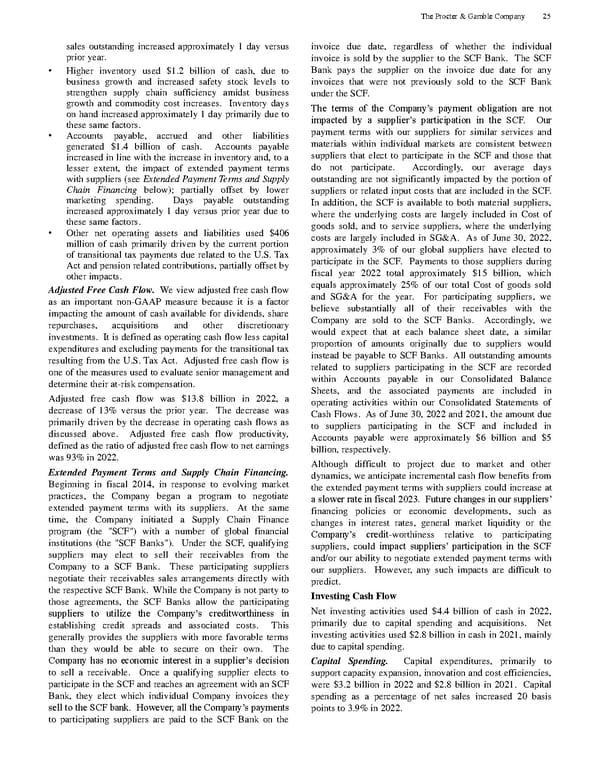sales outstanding increased approximately 1 day versus prior year. • Higher inventory used $1.2 billion of cash, due to business growth and increased safety stock levels to strengthen supply chain sufficiency amidst business growth and commodity cost increases. Inventory days on hand increased approxima tely 1 day primarily due to these same factors. • Accounts payable, accrued and other liabilities generated $1.4 billion of cash. Accounts payable increased in line with the increase in inventory and, to a lesser extent, the impact of extended payment ter ms with suppliers (see Extended Payment Terms and Supply Chain Financing below); partially offset by lower marketing spending. Days payable outstanding increased approximately 1 day versus prior year due to these same factors. • Other net operating assets a nd liabilities used $406 million of cash primarily driven by the current portion of transitional tax payments due related to the U.S. Tax Act and pension related contributions, partially offset by other impacts. Adjusted Free Cash Flow. We view adjusted f ree cash flow as an important non - GAAP measure because it is a factor impacting the amount of cash available for dividends, share repurchases, acquisitions and other discretionary investments. It is defined as operating cash flow less capital expenditures and excluding payments for the transitional tax resulting from the U.S. Tax Act. Adjusted free cash flow is one of the measures used to evaluate senior management and determine their at - risk compensation. Adjusted free cash flow was $13.8 billion in 20 22, a decrease of 13% versus the prior year. The decrease was primarily driven by the decrease in operating cash flows as discussed above. Adjusted free cash flow productivity, defined as the ratio of adjusted free cash flow to net earnings was 93% in 20 22. Extended Payment Terms and Supply Chain Financing. Beginning in fiscal 2014, in response to evolving market practices, the Company began a program to negotiate extended payment terms with its suppliers. At the same time, the Company initiated a Supp ly Chain Finance program (the "SCF") with a number of global financial institutions (the "SCF Banks"). Under the SCF, qualifying suppliers may elect to sell their receivables from the Company to a SCF Bank. These participating suppliers negotiate their r eceivables sales arrangements directly with the respective SCF Bank. While the Company is not party to those agreements, the SCF Banks allow the participating suppliers to utilize the Company’s creditworthiness in establishing credit spreads and associate d costs. This generally provides the suppliers with more favorable terms than they would be able to secure on their own. The Company has no economic interest in a supplier’s decision to sell a receivable. Once a qualifying supplier elects to participate in the SCF and reaches an agreement with an SCF Bank, they elect which individual Company invoices they sell to the SCF bank. However, all the Company’s payments to participating suppliers are paid to the SCF Bank on the invoice due date, regardless of w hether the individual invoice is sold by the supplier to the SCF Bank. The SCF Bank pays the supplier on the invoice due date for any invoices that were not previously sold to the SCF Bank under the SCF. The terms of the Company’s payment obligation are n ot impacted by a supplier’s participation in the SCF. Our payment terms with our suppliers for similar services and materials within individual markets are consistent between suppliers that elect to participate in the SCF and those that do not participate . Accordingly, our average days outstanding are not significantly impacted by the portion of suppliers or related input costs that are included in the SCF. In addition, the SCF is available to both material suppliers, where the underlying costs are large ly included in Cost of goods sold, and to service suppliers, where the underlying costs are largely included in SG&A. As of June 30, 2022, approximately 3% of our global suppliers have elected to participate in the SCF. Payments to those suppliers during fiscal year 2022 total approximately $15 billion, which equals approximately 25% of our total Cost of goods sold and SG&A for the year. For participating suppliers, we believe substantially all of their receivables with the Company are sold to the SCF Ba nks. Accordingly, we would expect that at each balance sheet date, a similar proportion of amounts originally due to suppliers would instead be payable to SCF Banks. All outstanding amounts related to suppliers participating in the SCF are recorded withi n Accounts payable in our Consolidated Balance Sheets, and the associated payments are included in operating activities within our Consolidated Statements of Cash Flows. As of June 30, 2022 and 2021, the amount due to suppliers participating in the SCF an d included in Accounts payable were approximately $6 billion and $5 billion, respectively. Although difficult to project due to market and other dynamics, we anticipate incremental cash flow benefits from the extended payment terms with suppliers could inc rease at a slower rate in fiscal 2023. Future changes in our suppliers’ financing policies or economic developments, such as changes in interest rates, general market liquidity or the Company’s credit - worthiness relative to participating suppliers, could impact suppliers’ participation in the SCF and/or our ability to negotiate extended payment terms with our suppliers. However, any such impacts are difficult to predict. Investing Cash Flow Net investing activities used $4.4 billion of cash in 2022, prima rily due to capital spending and acquisitions. Net investing activities used $2.8 billion in cash in 2021, mainly due to capital spending. Capital Spending. Capital expenditures, primarily to support capacity expansion, innovation and cost efficiencies, were $3.2 billion in 2022 and $2.8 billion in 2021. Capital spending as a percentage of net sales increased 20 basis points t o 3.9% in 2022. The Procter & Gamble Company 25
 The Procter & Gamble Annual Report Page 36 Page 38
The Procter & Gamble Annual Report Page 36 Page 38